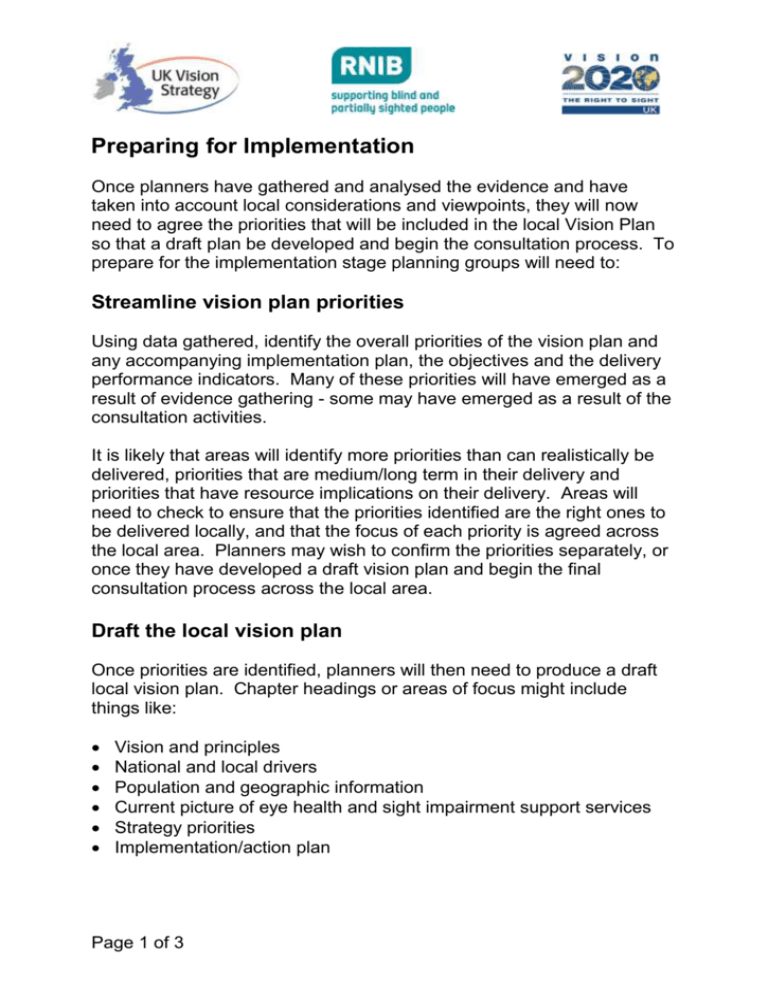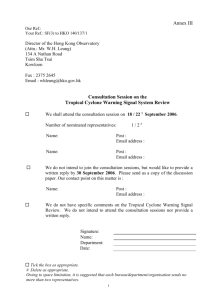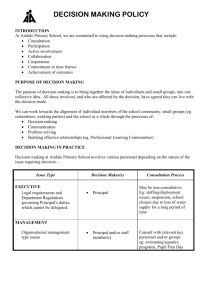Preparing for Implementation (Word, 496 KB)
advertisement

Preparing for Implementation Once planners have gathered and analysed the evidence and have taken into account local considerations and viewpoints, they will now need to agree the priorities that will be included in the local Vision Plan so that a draft plan be developed and begin the consultation process. To prepare for the implementation stage planning groups will need to: Streamline vision plan priorities Using data gathered, identify the overall priorities of the vision plan and any accompanying implementation plan, the objectives and the delivery performance indicators. Many of these priorities will have emerged as a result of evidence gathering - some may have emerged as a result of the consultation activities. It is likely that areas will identify more priorities than can realistically be delivered, priorities that are medium/long term in their delivery and priorities that have resource implications on their delivery. Areas will need to check to ensure that the priorities identified are the right ones to be delivered locally, and that the focus of each priority is agreed across the local area. Planners may wish to confirm the priorities separately, or once they have developed a draft vision plan and begin the final consultation process across the local area. Draft the local vision plan Once priorities are identified, planners will then need to produce a draft local vision plan. Chapter headings or areas of focus might include things like: Vision and principles National and local drivers Population and geographic information Current picture of eye health and sight impairment support services Strategy priorities Implementation/action plan Page 1 of 3 Many of the above headings link to sections contained within the planning guidance and can help areas consider what may be important to include in their local vision plan. Areas can also include additional or alternative chapters in their own plan. Will areas need an action/implementation plan(s)? Will areas need an additional action or implementation plan or plans to manage the delivery of your vision plan? If so, will areas need one overall action plan, one for each of your sector partners, or one each for specific geographical areas? Are there any sectors or partners with particular expertise in delivering or evaluating an element of your strategy/plan? Develop the approach that best matches local needs and issues. Undertake a draft Vision Plan consultation Once planning group members have agreed priorities and their importance, it is important to check with local partners, patients and service users whether the vision plan reflects the needs, issues and priorities of the local area. Areas should consider whether they wish to undertake a consultation, and how long the consultation period would be. The average consultation time is around three months. Vision Plan sign off It is likely that planners will need to get strategic sign off or endorsement of your vision plan before beginning the implementation process. Planning groups should have made the links with strategic decision making boards at the beginning of the process, so they should be aware of the vision plan, how it was developed and the identified priorities. Planning groups should also be aware of the timetable for decisions by local strategy or advisory Boards/Panels/Groups. Consider the resource implications As identified in section one, planners will need to agree how they will address identified resource considerations to support implementation. Areas should be clear about how they might address resource implications once they have reached the point of producing a draft Page 2 of 3 strategy. Areas may also have identified services where a business case will need to be developed to support service delivery. Monitoring and evaluating service delivery Consider how Vision Plan implementation will be monitored including the impact of the plan, the planning group and changes to service delivery as a result of identified priorities. Identified priorities may also be delayed, become obsolete or change - this also needs to be monitored. Areas should also consider how they might measure the economic or social impact of the Vision Plan and the planning process, particularly in areas that service delivery by two sectors (see section 10 for guidance). Planning groups may decide to launch the vision plan before implementation begins. Alternatively, groups may decide to go straight to implementation. Areas will need to consider what resources there are for launching the document, and the type of launch they wish to undertake. Summary Once planning groups have reached this point, they would have developed a Vision Plan, alongside any action or implementation plans. Planning groups may also have begun to identify and evidence some of the benefits of evidence based co-planning and co-production as a result of the planning process, which might include: Clearer understanding of the current and future considerations for eye health and sight loss support enabling you to jointly forward plan services and resources Better understanding of the remit of partners across Health, Local Authority and the Voluntary Sector Better able to engage local people in strategic planning of services There are likely to be several other benefits identified by planning groups; use these to disseminate the impact of the group and its identified priorities and plans. Page 3 of 3






